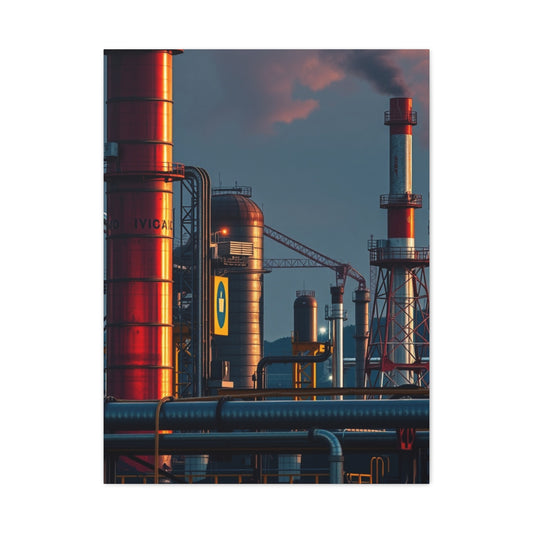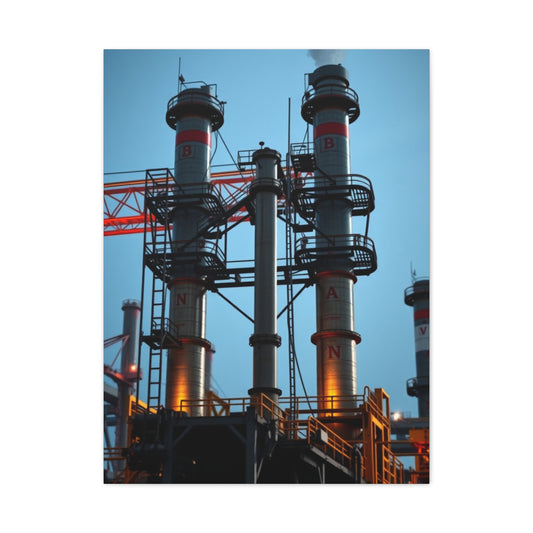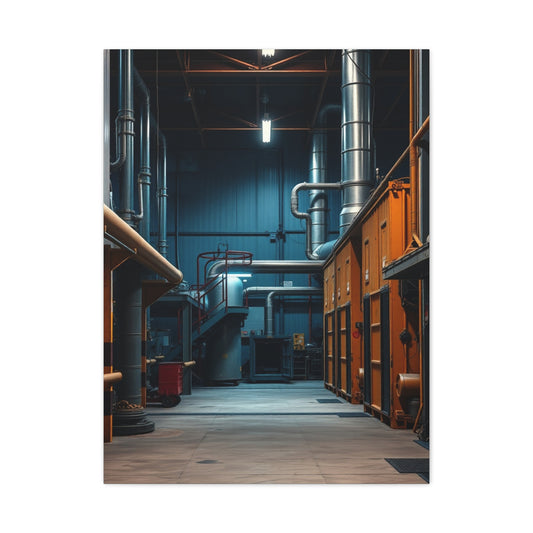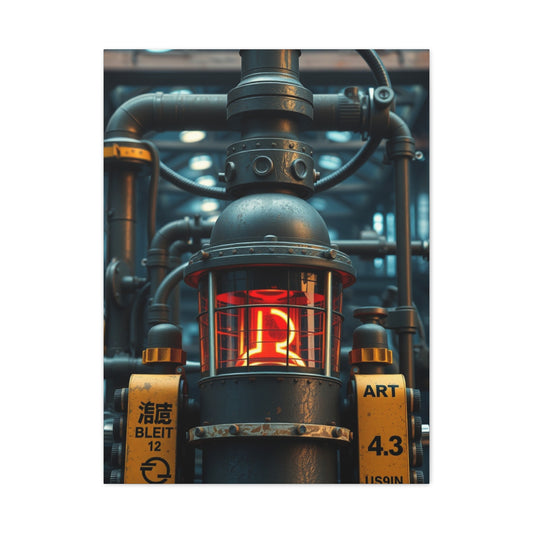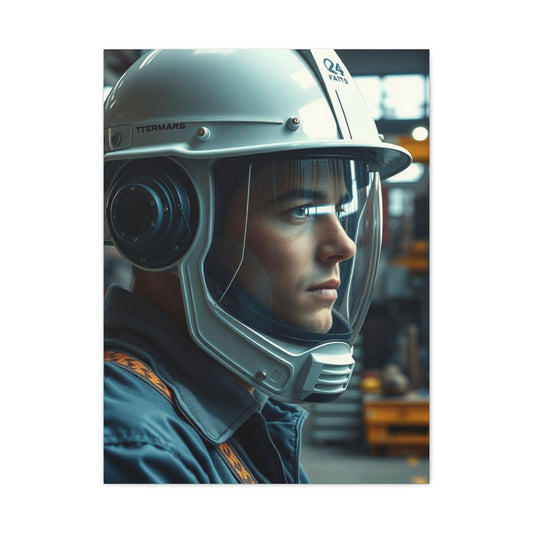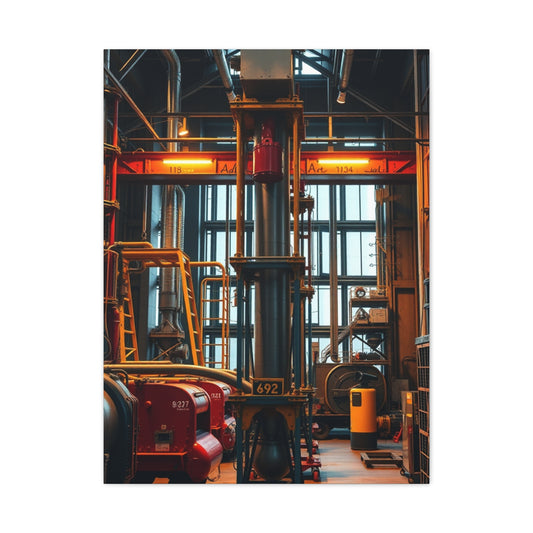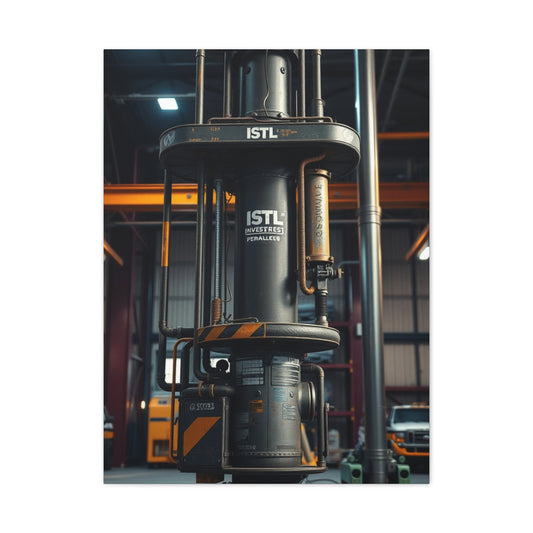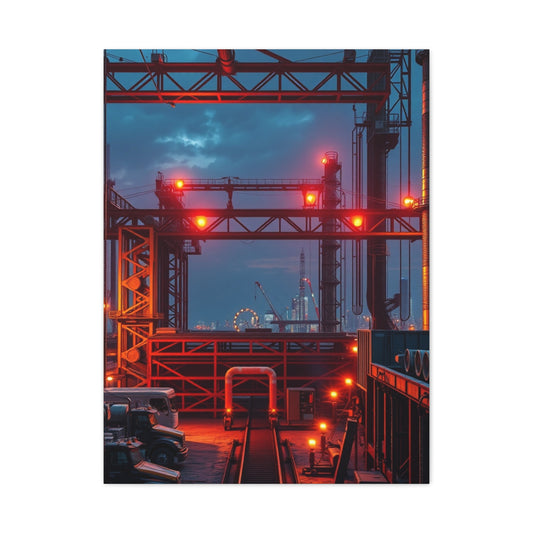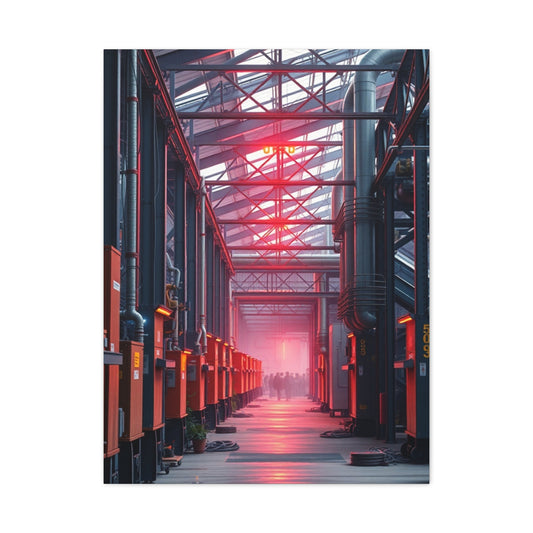Industrial Wall Art: Merging Raw Textures with Refined Style
Industrial wall art has become a defining feature of modern interior design, reshaping the way spaces are perceived and experienced. It brings an evocative quality into the home, merging raw materials with deliberate artistry. The essence of this style lies in its ability to emphasize imperfection as beauty, capturing the rugged charm of exposed metal, weathered surfaces, and utilitarian forms. Unlike traditional decor that often leans on ornate embellishments, industrial wall art thrives on authenticity and understated grandeur.
In a luxurious living room setting, a massive metallic propeller serves as the commanding centerpiece. Its sheer scale dominates the space, instantly becoming the focal point that dictates the visual narrative of the room. The piece radiates strength while exuding an almost sculptural allure, balancing between functional design and abstract artistry. This interplay creates a powerful impression—one that encapsulates the boldness and resilience of industrial design while imbuing the room with undeniable sophistication.
The presence of such artwork transforms the living space into a curated gallery. Guests are drawn to its intricate textures, its sheen reflecting subtle glimmers under carefully placed lighting. It does more than decorate; it establishes a sense of permanence and narrative, grounding the interior in history and character.
Contrasts That Define Industrial Aesthetics
The striking appeal of industrial wall art often emerges from its juxtapositions. When raw metallic finishes are set against deeply pigmented walls—such as teal or slate gray—the result is a dynamic tension that enhances both elements. The cool strength of steel or iron interacts with the softness of velvet furnishings or polished wood, reminding us that contrasts create harmony in design.
Concrete surfaces, with their tactile grain and muted tonality, amplify the ruggedness of industrial pieces. Their unrefined textures provide a backdrop that celebrates imperfection. Instead of concealing flaws, the walls and artwork emphasize them as essential components of beauty. This philosophy runs through industrial design, where rivets, bolts, and weld marks are not hidden but displayed as artistic statements.
By layering different materials—metal, glass, concrete, and wood—the atmosphere acquires depth and complexity. Each surface tells its own story, and together they form a visual symphony that feels both urban and timeless. The industrial wall art anchors this harmony, becoming the thread that unifies the varied textures into a coherent whole.
Lighting as an Enhancer of Industrial Expression
The impact of industrial wall art is amplified through lighting. A well-placed LED strip or pendant lamp does more than illuminate—it dramatizes. Metallic artwork interacts with light in fascinating ways, casting elongated shadows, glimmering highlights, and subtle reflections that alter throughout the day. These nuances turn a static object into a living feature within the space.
In the case of the propeller installation, concealed LED strips wash the piece with a soft glow, highlighting the brushed metal and creating gentle gradients across its blades. Shadows play upon the surrounding walls, extending the artwork’s presence beyond its physical boundaries. The atmosphere shifts from daytime vibrancy to nighttime intimacy, with lighting shaping the mood in profound ways.
The deliberate use of industrial-style lighting fixtures—exposed bulbs, metal cages, and aged finishes—further reinforces the character of the room. These elements frame the artwork, ensuring it remains integrated within the overall aesthetic rather than appearing isolated. Light, in this context, is not merely functional but a narrative tool, shaping the viewer’s perception of both space and object.
Emotional Resonance and Symbolism
Industrial wall art carries with it an emotional weight that transcends visual appeal. Its forms often evoke movement, resilience, and the endurance of time. A propeller, for instance, symbolizes progress and momentum, echoing the spirit of invention and industry. Such symbolism resonates subtly within a living room, infusing the space with energy and vitality.
The tactile surfaces invite touch and contemplation, encouraging viewers to engage with the piece on a sensory level. Unlike smooth, flawless artwork, industrial pieces often reveal layers of history—scratches, dents, and patinas that suggest stories of use and endurance. This quality makes them feel lived-in, authentic, and deeply human.
The presence of these pieces alters the emotional tone of a room. They provide grounding, stability, and structure, while also offering intrigue and curiosity. A guest may find themselves reflecting on the origins of the material, the hands that shaped it, or the industrial landscapes it might have once belonged to. In this way, industrial wall art transforms ordinary walls into portals of imagination.
Blending Ruggedness with Comfort
One of the most captivating aspects of industrial design is its ability to balance rugged elements with comfort. While wall art crafted from metal or salvaged materials may seem austere, pairing them with plush furnishings creates a harmonious equilibrium. A velvet sofa or a mirrored coffee table softens the raw edge of the artwork, ensuring the room feels both inviting and refined.
Textures play a crucial role in this balance. Smooth surfaces like polished marble or glass offset the roughness of metal and concrete, creating a dialogue between opposites. Warm textiles—rugs, throws, and cushions—provide layers of softness, making the space comfortable without diluting its industrial spirit.
This balance ensures that industrial interiors do not feel cold or mechanical. Instead, they exude warmth through intentional layering, proving that even the most rugged art can coexist beautifully with luxury and elegance.
The Role of Scale in Industrial Design
Scale is essential when incorporating industrial wall art. Larger pieces are particularly impactful, as they echo the monumental scale of factories, warehouses, and machinery from which this aesthetic draws inspiration. Oversized artwork does not simply occupy wall space; it dominates it, establishing authority and shaping the flow of the room.
The grandeur of large-scale industrial art can turn a simple living room into a statement space. It demands attention, setting the tone for all other design elements. Smaller accents—such as metallic vases, geometric side tables, or minimalist shelving—then support the main piece, contributing to a layered but cohesive design.
The principle of scale ensures balance within the room. While the artwork may be monumental, the surrounding decor provides counterpoints that prevent the space from feeling overwhelming. Together, they create a measured rhythm, much like the balance between heavy machinery and human craftsmanship in industrial settings.
Craftsmanship and Authenticity
Industrial wall art often reflects a celebration of craftsmanship. Each piece, whether sculpted metal, distressed wood, or abstract machinery-inspired design, emphasizes the hand of the maker. Imperfections are embraced rather than erased, showcasing authenticity in its purest form.
The appreciation of such art aligns with the ethos of industrial design: honoring materials for what they are. A rusted patina is not concealed but highlighted; a visible weld is not polished away but becomes a mark of artistry. These details elevate the artwork beyond decoration, positioning it as a testament to durability and creativity.
This authenticity resonates deeply in a modern world saturated with mass production. Industrial wall art feels singular, carrying traces of individuality and history. It reminds us that beauty can be found in rawness and artistry in imperfection.
Industrial Art as a Narrative Element
Every piece of industrial wall art tells a story. It may recall the era of rapid mechanization, the resilience of workers, or the beauty of urban landscapes. In residential interiors, these narratives weave seamlessly into the lives of the inhabitants, enriching their daily experiences.
For example, a panel featuring mechanical schematics can evoke curiosity and intellectual engagement, while an abstract metallic installation may spark conversations about form and movement. The narratives embedded in industrial art are not prescriptive; they leave room for interpretation, allowing each viewer to project their own associations and emotions.
In this way, the artwork becomes more than decor—it becomes a narrative thread within the broader tapestry of the home.
The Transformative Nature of Industrial Wall Art
Industrial wall art holds a unique place in interior design because it is not simply ornamental. Instead, it has the capacity to transform the atmosphere of a room, shaping the way it feels and how people experience it. Unlike other decorative elements that merely fill empty spaces, industrial artwork commands presence, becoming a catalyst for ambiance and mood.
The essence of industrial design lies in its embrace of rawness, and wall art within this aesthetic embodies that philosophy. Metal, concrete, distressed wood, and exposed textures are not hidden or disguised; they are celebrated. The artwork often carries with it the aura of history, evoking echoes of workshops, factories, and urban landscapes. When brought into residential interiors, these elements redefine the space, making it feel simultaneously grounded and elevated.
At its core, industrial wall art conveys strength and authenticity. Its surfaces bear marks of time, textures that narrate their own stories. This storytelling dimension becomes an intrinsic part of the atmosphere, providing rooms with a sense of depth and character that transcends mere decoration.
Anchoring the Room with a Central Piece
A hallmark of industrial wall art is its ability to serve as an anchor. Whether it is an oversized propeller, an abstract metallic sculpture, or a large canvas featuring mechanical forms, such pieces instantly establish the mood of the space. They set the design vocabulary, dictating how other elements should harmonize within the room.
In one living room setting, a massive metal installation not only drew the eye but seemed to redefine the proportions of the space. The artwork did not blend passively into the background; it asserted itself as the guiding presence around which all other furnishings and details orbited. By doing so, it provided a sense of structure that made the interior feel complete.
The anchoring role of industrial wall art ensures that a room does not feel fragmented. It creates unity by acting as the central theme, much like a conductor guiding an orchestra. The textures, colors, and materials introduced through the artwork resonate throughout the space, influencing every corner.
The Play of Light and Shadow
Light is inseparable from the effectiveness of industrial wall art. The interplay of illumination and shadow transforms static objects into dynamic experiences. Metallic finishes glisten under warm lighting, concrete surfaces absorb and diffuse glow, while exposed fixtures cast angular shadows that animate walls.
The artistry of lighting lies in its ability to enhance details. A brushed steel sculpture acquires dimension when raked light reveals its grain. A set of gears mounted on the wall takes on a new personality when shadows exaggerate their forms, giving the impression of movement. These shifting qualities make industrial artwork feel alive, ensuring it evolves throughout the day as natural and artificial light intermingle.
Strategically positioned fixtures can also frame the artwork, guiding attention without overwhelming the eye. Pendant lamps with aged brass finishes, bare Edison bulbs, or linear LED strips all align with industrial aesthetics while ensuring the art remains integrated into the spatial composition. Light, therefore, becomes a co-creator, partnering with the artwork to cultivate ambiance.
Emotional Energy and Symbolic Strength
Beyond their physical qualities, industrial art pieces infuse a room with symbolic strength. Many designs are inspired by machinery, tools, or architectural elements, embodying concepts of resilience, progress, and innovation. This symbolism extends into the emotional atmosphere of a home, reminding inhabitants of endurance and transformation.
For instance, a wall piece shaped like a propeller resonates with movement, speed, and dynamism. It evokes the energy of travel and industrial invention, instilling the space with vitality. Similarly, artwork that reveals gears, rivets, or blueprints can suggest precision and craftsmanship, appealing to those who appreciate functionality as beauty.
This infusion of meaning deepens the impact of industrial wall art. It elevates interiors from being purely aesthetic environments to being emotionally charged spaces where design becomes a form of storytelling. Guests are not merely admiring surfaces; they are engaging with ideas and histories embedded in the artwork.
Creating Balance with Comfort and Luxury
Industrial interiors often run the risk of feeling austere if not carefully balanced. The strength of steel, the coolness of concrete, and the rawness of exposed surfaces can overwhelm without softer counterparts. This is where the balance between rugged art and luxurious furnishings becomes essential.
Imagine a living room where an immense metallic panel dominates one wall. To prevent the atmosphere from becoming overly stark, velvet sofas in deep jewel tones provide warmth. A chandelier with crystal droplets diffuses light gently, softening the edges of the industrial features. Mirrored side tables reflect both the art and the lighting, creating a sense of cohesion while infusing elegance.
This layering of softness and ruggedness creates a tactile equilibrium. The industrial artwork retains its boldness, but the plush surroundings invite comfort. The result is a space that feels both strong and welcoming, modern yet timeless. The art is not diminished by comfort, nor is comfort diminished by art; instead, they reinforce one another.
Scale and Proportion in Industrial Expression
The effectiveness of industrial wall art often lies in its scale. Large-scale pieces echo the monumental proportions of industrial architecture, from cavernous factories to sprawling warehouses. These oversized works create a sense of grandeur, instantly commanding attention.
However, scale must be carefully orchestrated to maintain balance. A massive metallic sculpture works best in a room with high ceilings or expansive walls, where it can breathe without suffocating the space. In more intimate settings, smaller yet equally detailed pieces—perhaps a series of framed blueprints or modest steel reliefs—achieve the same atmosphere without overwhelming.
Proportion also plays a role in how an artwork relates to its surroundings. A tall, narrow piece might echo the verticality of industrial windows, while a wide, horizontal installation may mirror the breadth of exposed beams or shelving. By aligning artwork with architectural cues, the space feels harmonious, as though every element belongs to the same visual language.
Material Authenticity and Textural Depth
One of the most striking qualities of industrial wall art is its unapologetic authenticity. Materials are rarely polished to perfection. Instead, they display their true character—scratches, oxidation, weathered edges, and irregular patterns. These imperfections are not flaws but features, reminding us of the passage of time and the value of endurance.
A rusted panel tells of exposure to the elements, while distressed wood reveals layers of use. Concrete carries subtle grains and fissures, evidence of its strength and impermanence simultaneously. These textures invite touch and contemplation, offering depth that flat, flawless surfaces cannot provide.
This authenticity resonates deeply with those who value sincerity in design. In an era dominated by sleek minimalism and synthetic finishes, industrial wall art stands apart as a celebration of the genuine. It honors the raw beauty of materials, giving interiors an unfiltered honesty.
Integrating Industrial Art into Eclectic Settings
Industrial wall art is remarkably versatile and can be integrated into eclectic settings without losing its essence. In spaces that embrace maximalism—layering colors, patterns, and textures—the ruggedness of industrial pieces provides grounding. A bold metallic artwork can act as a stabilizing force among vibrant fabrics and whimsical decor, preventing the room from feeling chaotic.
In bohemian-inspired settings, industrial art adds edge and contrast. The softness of woven tapestries, patterned rugs, and organic shapes gains tension when paired with structured metallic forms. Similarly, in contemporary minimalist interiors, a singular industrial piece can act as the statement feature, injecting depth into otherwise understated environments.
This adaptability demonstrates the wide appeal of industrial wall art. It is not restricted to one aesthetic but can complement many, providing contrast, balance, or emphasis as needed.
Nature as a Counterbalance
One way to soften the strength of industrial art is through the introduction of natural elements. Greenery, wooden accents, and floral arrangements provide contrast while harmonizing with the artwork’s authenticity. The juxtaposition of steel against leaves, or concrete against soft blooms, creates a dialogue between the man-made and the organic.
Plants placed strategically near industrial artwork add vibrancy and movement, softening hard edges with organic curves. A climbing plant draping over the corner of a metallic piece can transform its severity into something more inviting, without erasing its rugged charm. Similarly, floral motifs in adjacent textiles echo natural beauty, ensuring balance in the overall composition.
By blending nature with industrial artwork, interiors achieve a symbiotic atmosphere—one where rawness and vitality coexist seamlessly.
Industrial Wall Art as a Reflection of Individuality
Perhaps the most compelling reason industrial wall art resonates with so many is its individuality. Each piece feels distinctive, carrying traces of uniqueness in its materials and design. Unlike mass-produced decor, industrial pieces often bear characteristics that cannot be replicated—variations in patina, irregularities in surface, or hand-forged details.
This individuality allows homeowners to curate spaces that feel personal and meaningful. The artwork becomes an extension of identity, reflecting values of authenticity, resilience, and appreciation for craftsmanship. Guests who enter such a room encounter not only the aesthetic but also the personality of its inhabitants, communicated through chosen pieces.
In this sense, industrial wall art transcends its role as a design element. It becomes a statement of individuality, a symbol of one’s relationship with materials, history, and artistic expression.
The Narrative Embedded in Industrial Art
Every piece of industrial wall art is more than a visual object; it is a narrative frozen in material form. Unlike ornamental paintings or purely decorative prints, these works often carry with them echoes of history, labor, and invention. A rusted gear, a weathered schematic, or a metallic sculpture shaped like machinery is not merely design—it is a story about resilience, ingenuity, and the passage of time.
The atmosphere of industrial wall art lies in its storytelling. Surfaces etched with scratches or bearing a patina of age invite viewers to imagine their origins. Was this metal once part of a ship, an airplane, or a factory machine? Were these designs inspired by the precision of engineers or the artistry of craftspeople? Such questions allow the artwork to become more than static decoration. It becomes a vessel of curiosity and meaning, sparking conversations and drawing people deeper into the ambiance of the room.
In interiors, these pieces remind us of the human capacity to create and endure. They celebrate industry not only as a force of progress but also as a domain where artistry emerges from raw functionality.
The Emotional Resonance of Materials
Industrial wall art derives much of its power from the materials it embraces. Metals such as steel, copper, and iron speak of strength and permanence. Concrete whispers of solidity and endurance. Distressed wood evokes history, age, and continuity. These materials embody qualities that resonate emotionally with those who encounter them.
A steel sculpture might project resilience, giving a sense of durability to the environment. Copper, with its warm patina, suggests transformation and the beauty of change over time. Wood, scarred yet enduring, carries the memory of nature meeting human hands. Together, these elements form a rich emotional vocabulary that influences the character of a room.
When incorporated into living spaces, industrial artwork composed of such materials becomes more than aesthetic—it becomes experiential. It instills a feeling of grounding, a reminder of authenticity in a world that often prizes perfection over sincerity.
Symbols of Movement and Progress
Many forms of industrial wall art are inspired by machinery—propellers, gears, pistons, or mechanical blueprints. These forms symbolize movement, progress, and the human desire to push boundaries. A propeller piece may evoke the spirit of exploration, hinting at journeys across oceans or skies. Gears can represent interconnectedness, collaboration, and the mechanics of progress itself.
This symbolism carries powerful resonance when placed in a living room or office. It imbues the space with a sense of dynamism, reminding inhabitants of forward momentum. The artwork becomes an emblem of ambition and vision, qualities that extend beyond design into the ethos of everyday life.
Such pieces are not abstract in meaning; they are charged with metaphors that enrich the emotional and intellectual environment of a space. The symbolism they carry ensures they are never passive background objects but active participants in the life of the home.
The Role of Scale in Storytelling
The scale of industrial wall art influences the intensity of its narrative. Oversized pieces convey monumental power, echoing the vastness of industrial spaces like warehouses and shipyards. They demand attention, their very size declaring significance. Smaller pieces, by contrast, invite intimacy. A framed blueprint or modestly scaled sculpture draws the viewer closer, encouraging quiet contemplation.
Both approaches are effective in different contexts. Large-scale industrial art dominates, setting the story for the entire room. Smaller works create pockets of narrative, allowing each corner to whisper its own tale. Together, they build a layered storytelling environment where viewers encounter different perspectives as they move through the space.
Scale, therefore, becomes not just a matter of proportion but of storytelling intensity. It dictates whether the narrative is shouted with authority or whispered with subtlety.
Lighting as Narrative Enhancement
Lighting transforms the storytelling of industrial wall art by emphasizing its textures and details. Shadows exaggerate the rugged edges of steel, while glimmers highlight brushed surfaces and rivets. The shifting qualities of light ensure that the story told by the artwork evolves throughout the day.
A dramatic spotlight can elevate a metallic propeller into a theatrical presence, while ambient glow from concealed strips can soften its edges, making it part of a serene narrative. Candlelight, with its flickering warmth, can transform even the most austere steel panel into something intimate and poetic.
Through lighting, the artwork’s narrative becomes multidimensional. It can be bold during social gatherings, commanding attention, and tender during quiet evenings, offering comfort. In this way, industrial wall art becomes dynamic storytelling rather than static imagery.
Layers of History and Memory
One of the most evocative aspects of industrial art is its relationship with history. Many pieces intentionally incorporate aged or distressed finishes that suggest the passage of time. Rust marks, chipped paint, or worn wood surfaces allude to long-forgotten eras of production, labor, and craftsmanship.
These layers of history imbue the artwork with memory. It feels as though each scratch or patina holds a story of use, of function, of purpose beyond the present. This quality provides depth not found in polished or flawless decor. It allows the artwork to function as both object and artifact, a piece of the past repurposed for contemporary storytelling.
This connection to history resonates in homes that value authenticity. It brings a sense of continuity, linking modern interiors with the industrial landscapes that shaped the world.
Balancing Symbolism with Comfort
Industrial wall art may carry weighty symbolism, but it must also coexist with comfort in residential spaces. A living room dominated by metallic art might risk feeling too mechanical without softer elements to counterbalance it. Plush seating, layered rugs, and warm-toned accents ensure the space remains welcoming.
The dialogue between the rugged and the refined enriches the symbolism rather than diminishing it. For example, a wall piece featuring gears gains added meaning when paired with a velvet sofa, symbolizing the coexistence of strength and comfort. A distressed steel panel beside a chandelier conveys a narrative of rawness meeting elegance.
This balance transforms the symbolism into lived experience, ensuring that industrial wall art contributes not only to narrative but also to the quality of daily life.
Individual Identity Through Industrial Art
Every choice of industrial artwork reflects individual identity. A homeowner drawn to propeller sculptures may resonate with themes of movement and exploration. Someone who selects framed machinery schematics might be expressing admiration for precision and innovation. These choices transform interiors into personal statements, where art becomes an extension of the self.
Unlike generic wall decor, industrial art feels deeply personal because of its distinctiveness. The patinas, textures, and imperfections ensure that no two pieces are truly alike. This uniqueness mirrors individuality, allowing interiors to become self-portraits of those who inhabit them.
By choosing industrial wall art, homeowners align themselves with values of authenticity, resilience, and creativity. The art becomes a silent yet profound expression of who they are and what they value.
The Storytelling Role of Arrangement
The way industrial wall art is arranged within a room further shapes its narrative. A solitary oversized piece may act as a proclamation, bold and definitive. A series of smaller pieces—such as a triptych of machinery-inspired paintings or a collection of framed blueprints—can tell a sequential story, guiding the viewer from one chapter to the next.
Placement is equally critical. Artwork positioned above a sofa becomes the anchor of social interaction. Pieces flanking a fireplace suggest symmetry and balance. A metallic sculpture hung near an industrial-style window can echo the architecture, blending the artwork seamlessly into the structural story of the space.
Arrangement, therefore, is storytelling choreography. It dictates how the narrative unfolds, ensuring that the artwork not only conveys meaning individually but also contributes to a broader dialogue within the interior.
Industrial Wall Art as Contemporary Mythmaking
In many ways, industrial wall art functions as contemporary mythmaking. It transforms tools, machines, and architectural fragments into symbols that transcend their original utilitarian roles. A propeller is no longer just a functional object but an emblem of exploration. A gear is not merely a mechanism but a metaphor for interconnectedness.
This mythmaking quality allows industrial interiors to feel both modern and timeless. The artwork situates the home within a larger narrative about human creativity, resilience, and transformation. It reminds us that even the most practical objects can carry profound beauty and meaning when reimagined as art.
Space as a Canvas for Industrial Art
Industrial wall art flourishes when given the right spatial context. Unlike smaller decorative accents that can be added almost anywhere, these pieces demand thoughtful placement and sufficient room to breathe. Walls are not merely backdrops in this design philosophy; they are canvases upon which the raw poetry of industrial aesthetics is painted.
A spacious living room, with high ceilings and unbroken wall surfaces, offers an ideal setting for oversized installations. Here, the vastness of space mirrors the scale of industrial origins—factories, workshops, shipyards—places defined by immensity. When an industrial artwork is positioned against such a wall, it feels natural, almost inevitable, as though the space was made for it.
In more intimate rooms, the scale of the artwork adapts, becoming refined rather than overwhelming. Smaller steel panels, framed machinery sketches, or subtle metallic accents create focus without crowding the environment. Thus, the relationship between artwork and space is symbiotic: the room frames the art, and the art transforms the room.
Texture as a Language of Authenticity
Texture is the language through which industrial wall art speaks. Smooth, polished metals reflect light with crisp precision, while distressed iron absorbs shadows, creating depth and mystery. Concrete surfaces provide tactile roughness, while reclaimed wood introduces warmth with its grain and imperfections.
These textures resonate differently depending on their context. Against a smooth plaster wall, a weathered steel installation becomes even more striking, its imperfections highlighted by contrast. Against exposed brick, metallic pieces blend into their architectural surroundings, forming continuity rather than contrast.
Textures are not decorative in isolation; they are communicators of history and authenticity. They remind viewers that beauty is often found in surfaces that bear marks of time, labor, and transformation. The tactile allure of industrial wall art invites not only visual appreciation but also an almost sensory engagement, where one imagines the coolness of metal or the ruggedness of stone.
The Dialogue Between Art and Architecture
Industrial wall art does not exist in isolation but enters into dialogue with architecture. Exposed beams, brick walls, concrete floors, and steel-framed windows all contribute to the visual conversation. The artwork amplifies these architectural elements, while the architecture, in turn, frames and contextualizes the artwork.
A metallic sculpture placed near a steel staircase feels like a continuation of its structure, blurring the boundaries between functional architecture and artistic expression. A large schematic displayed beside industrial-style windows resonates with the geometry of the frames, reinforcing the aesthetic of precision and structure.
This integration prevents industrial wall art from feeling like an afterthought. Instead, it becomes an intrinsic part of the architecture, weaving itself into the very identity of the space.
The Importance of Negative Space
While industrial wall art is often bold and commanding, the role of negative space should not be underestimated. Empty walls surrounding the artwork allow the eye to rest, ensuring the piece remains a focal point rather than being lost in visual clutter.
Minimalist arrangements enhance the grandeur of oversized pieces. A single propeller on a vast wall carries immense power precisely because it is unchallenged by competing visuals. Similarly, a small grouping of metallic accents in a hallway becomes captivating because the surrounding space allows them to shine.
Negative space is not absence but presence. It frames the artwork, emphasizes its scale, and ensures that its textures and details are appreciated fully.
Light as a Sculptural Element
Light does not merely illuminate industrial wall art; it sculpts it. The interplay of brightness and shadow across uneven surfaces transforms static objects into dynamic compositions. As natural light shifts throughout the day, metallic finishes gleam, fade, and reveal new nuances.
Artificial lighting extends this transformation into the night. Adjustable spotlights can draw attention to specific textures, while ambient LED strips wash walls in soft glows that dramatize the artwork. Light reflects differently off brushed steel, oxidized copper, or polished aluminum, creating constantly evolving impressions.
In this sense, lighting becomes an extension of the artwork itself. It collaborates with the piece to create atmosphere, ensuring the space feels alive and responsive rather than static.
Balance of Ruggedness and Refinement
The success of industrial interiors lies in balance. Industrial wall art brings ruggedness—metallic, raw, unpolished. But when paired with refined elements, the overall effect is harmonious rather than harsh. A distressed iron panel above a sleek marble fireplace, or a weathered wooden installation against a velvet sofa, demonstrates the elegance that emerges from contrast.
This balance ensures industrial design is not reduced to austerity. Instead, it celebrates both the raw and the refined, showing how imperfection can coexist with luxury. Industrial wall art plays a central role in this dialogue, bridging the gap between comfort and rugged authenticity.
Functional Objects as Art
Another intriguing facet of industrial wall art is its ability to blur the boundaries between function and decoration. Objects created for utility—gears, valves, pulleys—are repurposed as aesthetic focal points. Their forms, stripped of context, are appreciated for symmetry, rhythm, and texture rather than their practical purpose.
A decommissioned propeller becomes a sculpture. A weathered factory mold becomes a wall-mounted installation. These transformations highlight the artistry inherent in industrial design, where utility and beauty were always intertwined.
By elevating functional objects into art, interiors gain layers of meaning. The pieces become testaments to ingenuity, celebrating both the practical and the poetic dimensions of industry.
Emotional Atmosphere Created by Texture and Scale
The textures and scales of industrial wall art influence the emotional atmosphere of interiors. Large metallic pieces imbue a space with power and authority, while smaller wooden installations evoke warmth and nostalgia. Smooth, reflective surfaces energize; rough, matte textures ground and calm.
Together, these elements orchestrate mood. A living room dominated by a massive steel propeller feels bold and assertive, while a bedroom adorned with a series of delicate machinery sketches feels contemplative and intimate. Industrial wall art adapts not only to space but to the emotional needs of the inhabitants.
The atmosphere is not accidental but curated. It emerges from choices of scale, texture, and placement, ensuring that the room resonates with a deliberate emotional cadence.
Harmony Between Collective and Individual Identity
While industrial design is rooted in collective history—factories, machines, the labor of many—it also allows for individual identity. Each piece of industrial wall art can be chosen to reflect personal narratives. A homeowner may connect with the symbolism of gears as metaphors for collaboration, or with the weathered patina of copper as a reminder of transformation.
Thus, the artwork operates on dual levels. It situates interiors within a broader industrial narrative while simultaneously reflecting the individuality of those who inhabit the space. This duality enriches the home, making it both universal and personal at once.
Curating a Layered Interior
Industrial wall art becomes most effective when integrated into a layered interior. The layers may include exposed architectural elements, varied materials, lighting, furniture, and smaller decorative accents. Together, they form a composition where the artwork is the anchor but not the sole participant.
A room with exposed brick walls, leather seating, metallic shelving, and oversized artwork feels immersive, almost theatrical. Each element plays a role in reinforcing the industrial narrative, while the wall art ensures the story remains cohesive and focused.
This layered approach prevents monotony, ensuring the space feels dynamic and evolving. Industrial wall art, by its bold presence, provides the rhythm around which other layers harmonize.
Integrating Industrial Wall Art in Diverse Spaces
Industrial wall art is uniquely versatile, capable of transforming a range of interior settings from expansive lofts to compact apartments. Its bold textures, metallic finishes, and commanding presence allow it to anchor rooms of varied scales while contributing a distinct personality to each. The key to integration lies in understanding both the space’s functional role and its desired emotional tone.
In living rooms, large-scale industrial pieces such as propellers, mechanical schematics, or abstract metallic sculptures become the focal point. Positioned above sofas, fireplaces, or console tables, they establish visual hierarchy and set the tone for surrounding decor. Here, the juxtaposition of plush furnishings, luxurious textiles, and rugged artwork ensures the space feels inviting while retaining the edge of industrial character.
Bedrooms benefit from a more nuanced approach. Oversized installations may overwhelm intimate spaces, so smaller compositions—wall-mounted gears, framed blueprints, or metallic reliefs—are often more effective. These pieces introduce industrial charm without compromising comfort. Coupled with jewel-toned bedding, layered textiles, and soft lighting, the artwork reinforces a balance of ruggedness and coziness, producing an environment that is both visually stimulating and restful.
In offices and study areas, industrial wall art communicates focus and productivity. Metallic maps, gear arrangements, or machinery-inspired abstract pieces evoke precision, engineering, and innovation. These works not only enhance aesthetics but also cultivate a workspace atmosphere conducive to concentration and creative thought.
Even kitchens and dining areas can embrace industrial artistry. Vintage metal panels, schematic prints, or distressed steel installations inject character into utilitarian spaces. Here, the wall art harmonizes with exposed shelving, industrial lighting, and concrete or wooden surfaces, creating interiors that are simultaneously functional and visually engaging.
Layering Industrial Art with Maximalist Design
The rise of maximalism in interiors has opened exciting avenues for industrial wall art. Maximalist spaces thrive on contrasts, textures, and layered visual experiences. Industrial artwork, with its bold lines, raw finishes, and historical resonance, offers grounding amid vibrant colors, patterned textiles, and eclectic decor.
Consider a bedroom featuring deep blue walls, jewel-toned bedding, and abundant greenery. A metallic wall sculpture or set of machinery-inspired prints introduces structured contrast. Its rugged textures and geometric forms provide rhythm and balance, preventing the space from feeling chaotic. Similarly, in living rooms with patterned rugs, velvet seating, and eclectic accessories, industrial wall art acts as a visual anchor, creating cohesion amid diverse elements.
Layering also extends to smaller decorative components. Shelves showcasing vintage tools, antique clocks, or metallic figurines complement larger wall pieces, reinforcing narrative and aesthetic continuity. Through this layering, industrial artwork transforms interiors into curated environments that celebrate both individuality and heritage.
Industrial Wall Art and Emotional Atmosphere
The emotional resonance of industrial wall art cannot be overstated. Its materials, scale, and symbolism influence the mood of a room in profound ways. A propeller installation or oversized metallic sculpture conveys energy and dynamism, instilling the space with a sense of forward motion. Conversely, smaller pieces such as gear arrangements or schematic prints offer introspection and contemplation, encouraging close engagement.
Textures amplify this emotional effect. Rough concrete, oxidized metals, and distressed wood surfaces evoke authenticity and history, grounding the room emotionally. Smooth, polished metals, on the other hand, introduce vibrancy and reflection, energizing the atmosphere. By carefully selecting and positioning these materials, interiors can balance boldness with serenity, creating rooms that are visually commanding yet emotionally harmonious.
Lighting further enhances emotional impact. Warm ambient lighting softens industrial textures, creating inviting spaces. Directed spotlights highlight details and shadows, adding drama and emphasizing the artwork’s sculptural qualities. Through careful curation of light, texture, and scale, industrial wall art transforms interiors into immersive experiences, affecting both sight and mood.
Combining Industrial Elements with Natural Accents
One of the most effective ways to integrate industrial wall art is by pairing it with natural elements. Greenery, wood, stone, and floral arrangements soften the starkness of metal and concrete, creating a dialogue between the raw and the organic.
In living rooms, a metallic wall installation framed by potted plants or a vertical garden can soften edges while emphasizing contrast. Bedrooms with industrial sketches or metallic panels benefit from wooden bedside tables, woven rugs, or botanical textiles. The interplay between the structured forms of industrial art and the irregular beauty of nature produces interiors that feel balanced, grounded, and inviting.
Even floral motifs in textiles or wall art can subtly echo industrial themes. Large-scale floral prints juxtaposed with exposed ductwork, metal columns, or industrial-style lighting create spaces that merge softness with strength, bridging classical elegance with contemporary ruggedness.
The Enduring Appeal of Industrial Wall Art
Industrial wall art has maintained its popularity because of its timeless qualities. Its celebration of raw materials, structural honesty, and functional beauty resonates across decades and trends. Unlike ephemeral decorative styles, industrial pieces convey permanence, authenticity, and narrative depth.
Part of this enduring appeal lies in adaptability. Industrial wall art harmonizes with traditional, modern, minimalist, and maximalist interiors. Its materials, scale, and symbolism can be tailored to suit diverse aesthetic preferences, from sleek urban lofts to cozy rustic homes. This versatility ensures its relevance in evolving design trends.
Additionally, industrial wall art provides individuality. Each piece, whether an aged metal panel, a vintage schematic, or a repurposed machine part, carries uniqueness. These characteristics allow homeowners to curate spaces that reflect personal history, taste, and sensibilities. In a world dominated by mass-produced decor, this authenticity and distinctiveness remain highly valued.
Industrial Wall Art in Contemporary Luxury
Modern interiors increasingly blend luxury with industrial elements. Industrial wall art plays a central role in this fusion, juxtaposing rugged materials with refined finishes. Polished metallic sculptures alongside velvet seating, distressed wood panels paired with marble surfaces, and exposed gear installations framed by crystal chandeliers create compelling contrasts.
These combinations highlight the capacity of industrial art to elevate spaces beyond utilitarian appeal. It introduces narrative, texture, and presence into interiors, transforming them into environments where elegance and authenticity coexist. The result is a refined aesthetic that feels modern, bold, and deeply personal.
Practical Considerations for Placement
Successful integration of industrial wall art requires attention to scale, proportion, and visual hierarchy. Oversized installations demand high ceilings or wide wall expanses, ensuring they dominate appropriately without crowding the space. Smaller pieces can be clustered in series or positioned strategically at eye level for intimacy and focus.
Materials and finishes should complement existing architectural features. Brushed steel pairs naturally with concrete walls, while oxidized copper or bronze resonates with exposed brick. Lighting should accentuate textures without causing glare, and adjacent furnishings should balance ruggedness with comfort.
Considering these practical factors ensures industrial wall art fulfills both aesthetic and functional purposes, creating cohesive and harmonious interiors.
The Future of Industrial Wall Art
Looking ahead, industrial wall art continues to evolve. Designers are experimenting with hybrid materials, combining metal, glass, wood, and even reclaimed plastics. Digital techniques allow for interactive installations that respond to light or movement, creating dynamic surfaces that transform throughout the day.
Customization and personalization are also growing trends. Homeowners increasingly seek pieces that reflect individual stories or regional industrial heritage. This approach aligns with the broader movement toward meaningful, narrative-driven interiors, where art serves as both decoration and identity marker.
Sustainability is another emerging factor. Reclaimed and recycled materials are increasingly incorporated into industrial art, emphasizing environmental responsibility while maintaining aesthetic integrity. These innovations ensure industrial wall art remains relevant, dynamic, and socially conscious.
Industrial Art Across Global Interiors
Globally, industrial wall art is influencing diverse interior traditions. In urban lofts in Europe and North America, it underscores architectural heritage, often integrating exposed brick, metal beams, and high ceilings. In contemporary Asian interiors, industrial art introduces contrast, pairing with minimalist designs and natural materials to create meditative, balanced spaces.
Even in smaller residences or adaptive reuse projects, industrial wall art imparts a sense of expansiveness. Vertical panels, modular metallic installations, or gear-inspired arrangements create focal points without overwhelming limited square footage. Its adaptability across cultural and spatial contexts reinforces its global appeal.
Conclusion
Industrial wall art stands as a testament to the beauty of raw materials, historical resonance, and thoughtful design. Across living rooms, bedrooms, offices, and kitchens, these pieces transform interiors by combining rugged textures, metallic finishes, and evocative symbolism. They anchor spaces, create focal points, and engage viewers with narratives of industry, ingenuity, and transformation. By harmonizing with diverse materials, furniture, lighting, and natural elements, industrial art balances strength with comfort, boldness with warmth, and history with modernity. Its versatility allows it to integrate seamlessly into minimal, maximalist, contemporary, or eclectic settings, offering both aesthetic appeal and emotional depth. Beyond decoration, industrial wall art reflects individuality, tells stories, and elevates spaces into curated environments rich with texture, mood, and character. Its timeless quality ensures that it continues to inspire, connecting the past, present, and future of interior design in a strikingly authentic and sophisticated manner.

